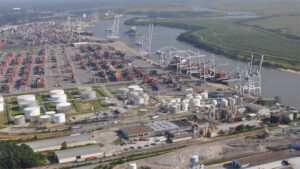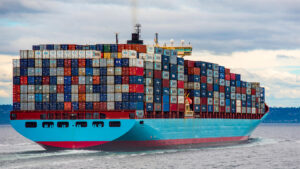No matter how much bubble wrap and caution tape we slap onto global maritime shipping, the industry has found itself in quite a predicament.
Despite the Ukraine War, a drought impacting the Panama Canal, Houthi attacks in Yemen, widespread piracy, and mounting geopolitical tensions in the South China Sea (yes, that is a lot of disruptions), the maritime shipping system has not cracked yet. However, it is very, very, very fragile.
The main thing propping up shipping in these more problematic regions is the emergence of ‘ghost fleets’ with alternative insurance policies. This insurance system is untested and unreliable, and as soon as one of the dominos falls, the entirety of the shipping system will follow.
The looming threat of a shipping collapse should terrify you. In case you need a supply chain refresher, manufacturing and global shipping is more interconnected than ever…so if the global shipping system fails, we’re in for a world of hurt.
Here at Zeihan On Geopolitics we select a single charity to sponsor. We have two criteria:
First, we look across the world and use our skill sets to identify where the needs are most acute. Second, we look for an institution with preexisting networks for both materials gathering and aid distribution. That way we know every cent of our donation is not simply going directly to where help is needed most, but our donations serve as a force multiplier for a system already in existence. Then we give what we can.
Today, our chosen charity is a group called Medshare, which provides emergency medical services to communities in need, with a very heavy emphasis on locations facing acute crises. Medshare operates right in the thick of it. Until future notice, every cent we earn from every book we sell in every format through every retailer is going to Medshare’s Ukraine fund.
And then there’s you.
Our newsletters and videologues are not only free, they will always be free. We also will never share your contact information with anyone. All we ask is that if you find one of our releases in any way useful, that you make a donation to Medshare. Over one third of Ukraine’s pre-war population has either been forced from their homes, kidnapped and shipped to Russia, or is trying to survive in occupied lands. This is our way to help who we can. Please, join us.
TranscripT
Hey everybody. Peter Zeihan here. Coming to you from a chilly day in Delray Beach, Florida, while chilly for Florida. It’s like 50. Today we’re going to talk about what’s going on in the world of maritime shipping and why we should be thankful that nothing has gone horribly wrong yet and why we should count on that. Continuing. Just a quick recap of what’s gone down in just the last couple of months.
We’ve got Ukraine taking accurate potshots at Russian energy facilities on the Baltic Sea at a place called Ust-Luga and on the Black Sea, a place called to Tuapse. And they’re reviewing up for an overseas hit. Now we’ve got a drought in Panama, which, based on goose numbers you’re using and whether you’re going by value or tonnage, has reduced the throughput of the Panama Canal by somewhere between one third and two thirds.
We’ve got Houthis in Yemen who are taking potshots at pretty much every other vessel that happens to go by them, which has reduced shipping through the Red Sea by about 10% for energy and cargo. we’ve got fresh piracy in places like Somalia. This really gone away in places like the Gulf of Guinea or the Strait of Malacca.
And we’ve got the Chinese making ever louder noises about wanting to change the security environment in their own neighborhood, even as the Russians are actively making roughly two thirds of the Black Sea a no go zone. It’s a long list. It’s getting longer by the day. But, but, but, but, but, but to this point, there has not been a meaningful break in the old system.
A big part of that is because of the insurance structure where every vessel who’s sailing anywhere has to get some sort of policy to insure both their whole and their cargo. And while with the ever tightening sanctions on the Russians because of Ukraine or to this point, that system has not been broken. It has been denied Russian shipping.
But Indian, Chinese and Russian state companies have stepped in to offer policies. And so far, none of the ships that have had problems anywhere have been under one of those policies. So what has happened is we’ve got this dual system where we have the the normal world where the Americans and especially the Europeans are providing the insurance for most of the shipping.
When you’ve got this ghost fleet that’s developed, mostly older vessels that were about to be decommissioned, that have been brought back and given a new lease on life as second rate cargo haulers, especially for liquids where they have a Chinese Indian or Russian insurance policy. This ghost fleet, based on whose numbers you’re using, that may be as much as 10% of the global tanker fleet.
And there’s also a few brokers and maybe, maybe, maybe even a few container ships that are kind of joining its ranks now to anything that the Russians can do to keep things under the table from the point of view of global record keeping and shipping. Now, what that means is that the risk has been deferred and absorbed by this shadow organization that has kind of popped up.
We’re now in a situation where we’re kind of in a holding pattern where we’re kind of waiting for like a real actual disruption to happen. But so far, no real country has targeted any sort of shipping. It’s not like the Japanese and the Chinese have started trying to block each other. The U.S. is still using its naval power to patrol the oceans where it can, and the biggest beneficiary of that system is none other than China.
And we don’t have the Russians or NAITO deliberately targeting each other’s commercial shipping yet. In fact, everyone is very will be closely sticking to the old structures. They’re just kind of trying to maneuver their own ways to get national and regional advantages. Now, this isn’t going to be long for the world. This is a very unstable sort of equilibrium that we have reached in early 2024.
And the that this is crazy that goes fleet is the reason why it’s all still working. It’s kind of a testament to the strategic inertia of the system. But now the buffer, the ghost lead is something that is largely documented, largely under the table. And if one of these ships gets into trouble, it’s an open question of whether or not the U.S. Navy will step in to help.
All of these are unknowns, which means as soon as that happens, a ghost fleet ship gets into trouble or a real country starts taking shots at another country’s shipping. We don’t just lose that buffer. We lose all of the insulation that we’ve managed to build up in the last two years, and we get a very quick breakdown much faster than we would have otherwise.
Now, based on what happens geopolitically, this could all go any number of directions. If the United States decides to take a shot at what the Iranians are doing in the Gulf, you know, that obviously takes us one direction. The Chinese decide to do something in the South China Sea that takes us another. If Ukraine accidentally hits an actual third party vessel in some of its anti-Russian operations and goes another, if the Russians are bored and captured, somebody go into a Ukrainian forward that takes another.
We’re on the edge. There’s a lot of guns aimed at our heads right now. And it honestly from my normal point of view, it doesn’t really matter which way this goes. It all leads to the same in place where long range shipping is simply no longer viable and shipping in general through dangerous areas is simply no longer viable.
And the two biggest places in the world that benefit from the current system are, ironically, Russian sanctions busting oil exports, which have to sail all the way around Eurasia and Chinese merchant US exports, who have to do the same thing. Those are the longest haul plays out there, all going through dangerous zones. So when this cracks, we see those two things get hurt first, but they will be far from alone.
Remember, East Asia is home to half of all manufacturing supply chain steps. There is no version of manufacturing in the world, especially when it comes to things like computing and electronics, where it works without that setup. And that requires global shipping to be safe. So we need to be prepared for the not too distant future when all of this just stops working.
And we have to figure out a fundamentally new model that’s probably going to be more based on regional trade rather than global. Okay, that’s plenty for the day. Take care.








